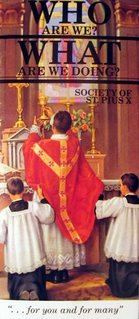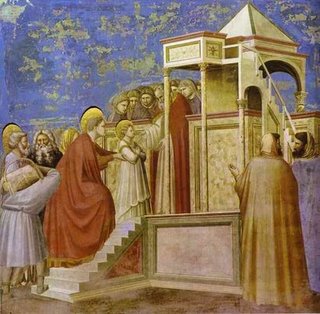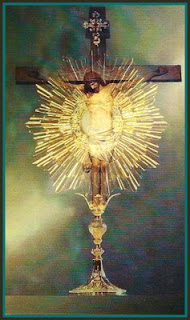I particularly liked this video segment produced by Grassroots Films on Eucharistic Processions in New York.
Read more >>
Saturday, November 25, 2006
"For whom is Jesus in the Most Blessed Sacrament? For me; because He loves me!" - St. Peter Julian Eymard
The practice of mandatory Priestly Celibacy was again recently upheld. I completely agree with this as I am preparing to become a seminarian. It is not possible to discern a priestly vocation while dating or discerning a vocation to marriage. One must take each step at a time. For a priest, celibacy is necessary to give his life completely to God.
"The value of the choice of priestly celibacy, according Catholic tradition, has been reaffirmed, and the need for solid human and Christian training, for seminarians as well as already ordained priests, has been reiterated,". This statement by the Vatican again reaffirms priestly celibacy.
Image Source: ICKSP Ordination Album
Related Posts:
Read more >>
"The value of the choice of priestly celibacy, according Catholic tradition, has been reaffirmed, and the need for solid human and Christian training, for seminarians as well as already ordained priests, has been reiterated,". This statement by the Vatican again reaffirms priestly celibacy.
Image Source: ICKSP Ordination Album
Related Posts:
Friday, November 24, 2006
 I ask all of my blog readers to say a prayer for the repose of the soul of Anita, the grandmother of St. Michael, the blogger from Who is like unto God. She died October 15, 2006.
I ask all of my blog readers to say a prayer for the repose of the soul of Anita, the grandmother of St. Michael, the blogger from Who is like unto God. She died October 15, 2006.Requiem aeternam dona ei, Domine, et lux perpetua luceat ei. Requiescat in pace. Amen.
Image Source: Photo of Archbishop Fulton J. Sheen, Believed to be in the Public Domain
 The Vatican declares that "Pro multis" means "for many":
The Vatican declares that "Pro multis" means "for many":"Cardinal Francis Arinze, the prefect of the Congregation for Divine Worship, has written to the heads of world's episcopal conferences, informing them of the Vatican decision. For the countries where a change in translation will be required, the cardinal's letter directs the bishops to prepare for the introduction of a new translation of the phrase in approved liturgical texts "in the next one or two years."
At last "For all" will be changed to the original meaning of "For many" in all English translations of the Eucharistic Prayer.
These changes will be reflected in the New Translation of the Roman Missal. Anyone even somewhat familiar with Latin could tell you that "multis" means many and not "all."

O God, the creator and redeemer of all the faithful, grant to the souls of thy servants and handmaids departed, the remission of all their sins; that through pious supplications they may obtain the pardon they have always desired. Who livest and reignest with God the Father in the unity of the Holy Ghost, God, world without end. Amen.
Remember to pray for the Holy Souls especially in November.
Thursday, November 23, 2006
Let us remember to thank God today for the many blessings we have received. Remember to say a special Blessing before your Thanksgiving meal today.
Suggestions for today:
- Invite someone to dinner who has no place to go for Thanksgiving.
- If you have no other commitments volunteer to help serve Thanksgiving dinner at a place which is serving the poor.
Collect:
O God of Whose mercies there is no number, and of Whose goodness the treasure is infinite: we render thanks to Thy most gracious Majesty for the gifts Thou hast bestowed upon us, always beseeching Thy clemeny; that as Thou grantest the petitions of them that ask Thee, Thou wilt prepare them for the greater rewards that still await them.
Secret:
Receive as a sweet savor, O Lord, this sacrifice of thanksgiving: do Thou in the future shield from all harm those whom until now Thou hast been pleased to hear and to save: and grant that they may serve Thee better and love Thee more. Through our Lord.
Post Communion:
O God, Who sufferest not that any who hope in Thee should e over afflicted, but listenest kindly to their prayers: we thank Thee for having heard our requests and granted our desires, and devoutly entreat Thee that what we have received may make us worthy to be delivered from all adversities. Through our Lord.
Wednesday, November 22, 2006
The Rorate Mass is said during Advent only by candlelight. Go to one this Advent.
Advent wreath: The Advent wreath, which has German origins, is probably the most recognized Advent custom. It is a wreath made of evergreens that is bound to a circle of wire. It symbolizes the many years from Adam to Christ in which the world awaited its Redeemer; it also represents the years that we have awaited His second and final coming. The wreath holds four equally spaced candles, the three purple ones lit on the “penitential” Sundays and a pink one for Gaudete, the joyful third Sunday in Advent. The traditional blessing of an Advent wreath, and the weekly prayers for the Advent wreath lighting, can be found online.
The empty manger: Each child may have his own individual manger, or there may be one manger for the whole family. The idea is that when acts of service, sacrifice, or kindness are done in honor of Baby Jesus as a birthday present, the child receives a piece of straw to put into the manger. Then, on Christmas morning, “Baby Jesus” is placed in the manger. Encourage your children to make Jesus’ bed as “comfortable” as possible through their good deeds. In the process, explain Christ’s incomparable self-gift at Christmas and Easter that enables us to be part of God’s family.
The Jesse tree: The Jesse tree tells about Christ’s ancestry through symbols and relates Scripture to salvation history, progressing from creation to the birth of Christ. The tree can be made on a poster board with the symbols glued on, or on an actual tree. See Fish Eaters for more information.
St. Nicholas Day: The feast of St. Nicholas is on Dec. 6th. It is a highlight of the Advent season. Each child puts out a shoe the night before St. Nicholas Day in the hope that the kind bishop — with his miter, staff, and bag of gifts — will pay a visit. The current “Santa Claus” is modeled after St. Nicholas, but commercialism has tarnished the true story. Many families give gifts on both Dec. 6 and Christmas. Leave your shoes by the door the evening of December 5th and fill them with candy!
The Christ candle: Any large white candle can be used for the Christ candle. The idea is to decorate it with symbols for Christ. Use old Christmas cards, sequins, holly, etc. The candle can be lit on Christmas Eve to show that the Light of the World has arrived. Then continue to light the Christ candle throughout the year at Sunday dinner to remind your family of our waiting for Christ, as well as celebrating His birth and Resurrection.
The Mary candle: Some families have the custom of decorating the Christ candle with a blue veil on December 8th, the Immaculate Conception. On this great feast, others place a candle with a blue ribbon before a statue or picture of the Blessed Virgin, whose “yes” to God enabled our Lord’s coming at Christmas. The candle is lit during meal times to serve as a delightful reminder of Mary’s eager expectation of the “Light of the World.” It can also serve as a reminder to each family member to keep their own light of grace burning as a preparation for Christ’s coming.
St. Lucy cakes: The feast of St. Lucy, virgin and martyr, is on December 13th. This marks the opening of the Christmas season in Sweden. Her life story can be found in most saints' books, as can the recipe for the traditional cakes. The symbolism is rich and her life story worthwhile reading.
The Nativity scene: This is the event in which the entire family shares — setting up the Christmas manger. Mary and Joseph should be far off traveling and their approach to Bethlehem can be adjusted daily. Older children can make life-size Nativity models, carve them, cut them out from cardboard, or set up pre-made figurines. The creative ideas are without limit. Make sure to place the Nativity scene where many can admire the children’s efforts to give God glory. And say the traditional family prayer to bless the Nativity scene when Christmas arrives.
Christmas baking: There are many recipe books available to find great traditional Christmas baking ideas. The baking usually starts around December 20th. As Christmas approaches, the house will smell of baking and fresh wreaths. The glory of Christmas is at hand! Move the manger to a focal point, add lights to the Nativity to be lighted on Christmas Eve, and anticipate together.
Blessing of the tree: More and more frequently families are blessing their Christmas trees. It is good to remind children that “the tree” relates to many aspects of our faith. For example, we are reminded that our first parents were not allowed to eat from one tree, and that Christ paid the great price for our redemption by hanging on a tree (cf. Acts 5:29-32). The Traditional Blessing for a Christmas Tree is quite beautifully said on Christmas Eve.
Adapted from the Catholic Education Center

"Do not, therefore, regard the bread and wine as simply that, for they are, according to the Master's declaration, the body and blood of Christ"
(St. Cyril of Jerusalem).
Tuesday, November 21, 2006
 Greater Double (1955 Calendar): November 21
Greater Double (1955 Calendar): November 21Memorial (1969 Calendar): November 21
Today is the celebration of Mary's presentation in Jerusalem, which has been celebrated since the sixth century in some places. At the age of three, shortly after she could walk, the Blessed Virgin ascended the 15 steps up to the Temple to consecrate Herself to God. It is reasonable to assume that Our Lady entered the Temple at that young age with the words of Psalm 83 in her heart: "How lovely are Thy tabernacles, O Lord of hosts; my soul longeth and fainteth for the courts of the Lord" (Ps 83:1,2).
One reads about Mary's presentation in the temple only in apocryphal literature. The Protoevangelium of James states that Mary was offered by Anna and Joachim to God in the Temple when she was three years old. This action was to carry out Anna's promise to God that she had made when she was childless.
Today's feast emphasizes the holiness conferred on Mary from the beginning of her life on earth through her final Assumption into Heaven. Unlike the Assumption and Immaculate Conception Feast, today is not a Holy Day of Obligation.
This is also the on which the Church celebrates the World Day of Cloistered Life, established by Pope Pius XII in 1953.
Dom Guerangers writes the following history of today's Feast in his Liturgical Year:
The East had been celebrating for seven centuries at least the entrance of the Mother of God into the temple of Jerusalem when in 1372 Gregory XI permitted it to be kept for the first time by the Roman court at Avignon. Mary in return broke the chains of captivity, that had bound the Papacy for seventy years; and soon the successor of St. Peter returned to Rome. The feast of the Visitation, as we saw on July 2nd, was in like manner inserted in the Western Calendar, to commemorate the re-establishment of unity after the schism which followed the exile.
In 1373, following the example of the Sovereign Pontiff, Charles V of France introduced the feast of the Presentation into the chapel of his palace. By letters dated 10th November 1374, to the masters and students of the college of Navarre, he expressed his desire that it should be celebrated throughout the kingdom: “Charles, by the grace of God king of the Franks, to our dearly beloved: health in him who ceases not to honor his Mother on earth. Among other objects of our solicitude, of our daily care and diligent meditation, that which rightly occupies our first thoughts is, that the blessed Virgin and most holy Empress be honored by us with very great love, and praised as becomes the veneration due to her. For it is our duty to glorify her; and we, who raise the eyes of our soul to her on high, know what an incomparable protectress she is to all, how powerful a mediatrix with her blessed Son, for those who honor her with a pure heart... Wherefore, wishing to excite our faithful people to solemnize the said feast, as we ourselves propose to do by God's assistance every year of our life, we send this Office to your devotion, in order to increase your joy.”
Such was the language of princes in those days. Now just at that very time, the wise and pious king, following up the work begun at Brétigny by our Lady of Chartres, rescued France from its fallen and dismembered condition. In the State then, as well as in the Church, at this moment so critical for both, our Lady in her Presentation commanded the storm, and the smile of the infant Mary dispersed the clouds.
The new feast, enriched with Indulgences by Paul II, had gradually become general, when St. Pius V, wishing to diminish the number of Offices on the universal Calendar, included this one among his suppressions. But Sixtus V restored it to the Roman Breviary in 1585, and shortly afterward Clement VIII raised it to the rank of Double Major. Soon the Clergy and Regulars adopted the custom of renewing their holy vows on this day, whereon their Queen had opened before them the way that leads by sacrifice to the special love of our Lord.
"Hail, holy throne of God, divine sanctuary, house of glory, jewel most fair, chosen treasure house, and mercy seat for the whole world, heaven showing forth the glory of God. Purest Virgin, worthy of all praise, sanctuary dedicated to God and raised above all human condition, virgin soil, unplowed field, flourishing vine, fountain pouring out waters, virgin bearing a child, mother without knowing man, hidden treasure of innocence, ornament of sanctity, by your most acceptable prayers, strong with the authority of motherhood, to our Lord and God, Creator of all, your Son who was born of you without a father, steer the ship of the Church and bring it to a quiet harbor"
(Adapted from a homily by St. Germanus on the Presentation of the Mother of God)
Collect:
O God, Who didst will that this day the ever blessed Virgin Mary, dwelling-place of the Holy Ghost, should be presented in the temple: grant, we beseech Thee, that through her intercession, we may be worthy to be presented in the temple of Thy glory. Through our Lord.
Prayer Source: 1962 Roman Catholic Daily Missal
Subscribe to:
Comments (Atom)
Copyright Notice: Unless otherwise stated, all items are copyrighted under a Attribution-NonCommercial-NoDerivatives 4.0 International License. If you quote from this blog, cite a link to the post on this blog in your article.
Disclosure of Material Connection: Some of the links on this blog are “affiliate links.” This means if you click on the link and purchase the item, I will receive an affiliate commission. As an Amazon Associate, for instance, I earn a small commission from qualifying purchases made by those who click on the Amazon affiliate links included on this website. I am disclosing this in accordance with the Federal Trade Commission’s 16 CFR, Part 255: “Guides Concerning the Use of Endorsements and Testimonials in Advertising.”
Disclosure of Material Connection: Some of the links on this blog are “affiliate links.” This means if you click on the link and purchase the item, I will receive an affiliate commission. As an Amazon Associate, for instance, I earn a small commission from qualifying purchases made by those who click on the Amazon affiliate links included on this website. I am disclosing this in accordance with the Federal Trade Commission’s 16 CFR, Part 255: “Guides Concerning the Use of Endorsements and Testimonials in Advertising.”
Support A Catholic Life. Your Patronage Helps Keep Us Updated and Online!
Become a Patron! Support Me On Patreon And Get Access to Exclusive Content, Free Catholic Books, Access to Discounts, and Much More!











